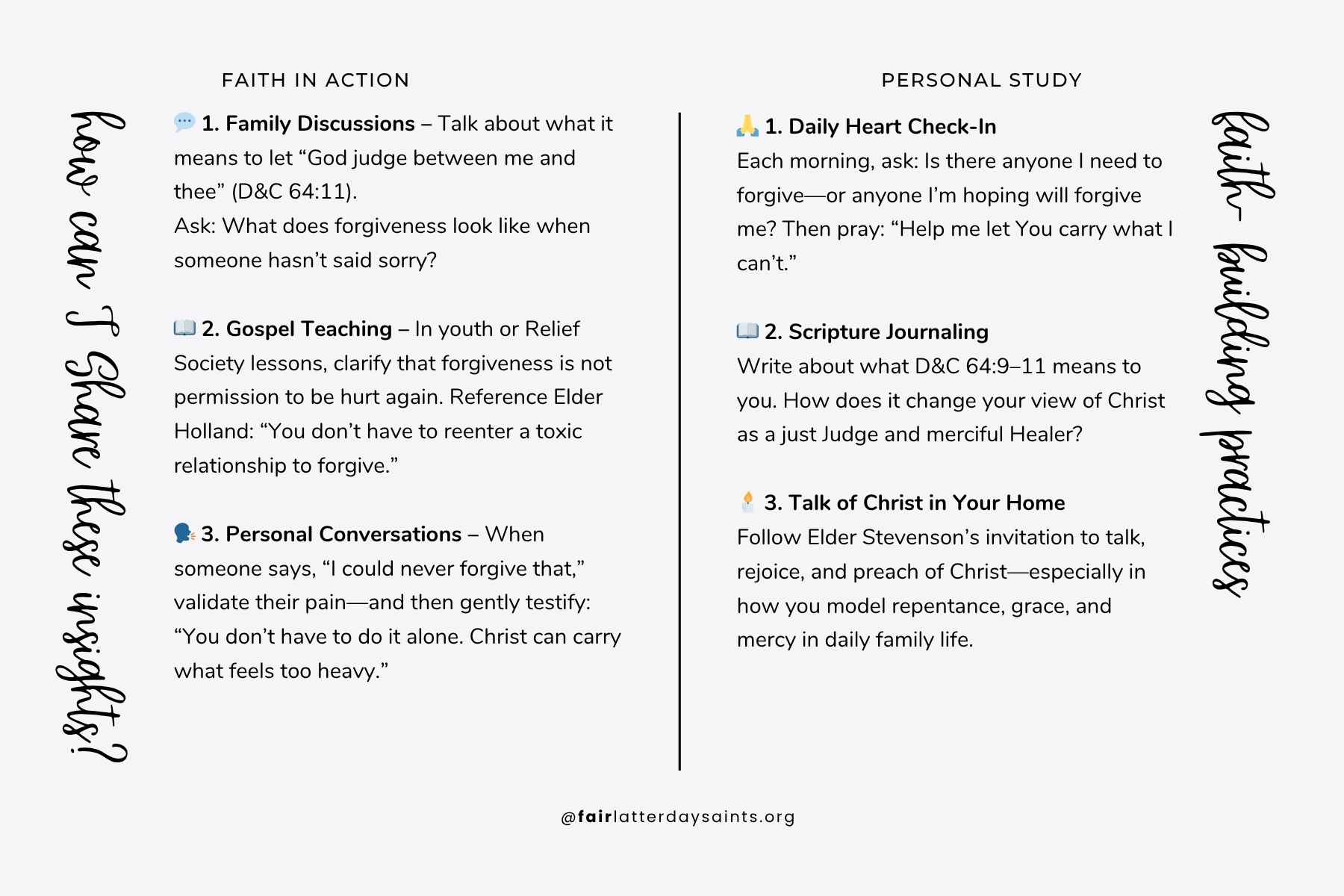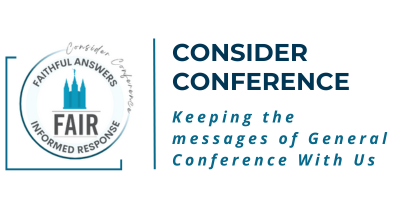
Receiving the Light of Christ—and Letting Go of What We Cannot Carry
Have you ever wondered what it actually means to forgive someone—especially when the pain they caused hasn’t gone away?
In his tender and Christ-centered address, And We Talk of Christ, Elder Gary E. Stevenson reminds us that Jesus Christ is the Light we receive—and the Light we share. His Atonement is not just about removing our sins, but about transforming our sorrows into peace and our suffering into joy.
Elder Stevenson rejoices in the “peace and hope” that come from forgiveness made possible by Christ’s atoning sacrifice. But how do we forgive when reconciliation feels impossible—or even unsafe? When we trust that the Savior’s sacrifice is sufficient for both justice and mercy, we can let go of the burden of judgment and step into healing. Forgiveness is not about excusing, forgetting, or reconciling—it’s about trusting Christ enough to release the pain.
As we study Doctrine and Covenants 64 this week, we hear the Lord Himself say: “Let God judge between me and thee, and reward thee according to thy deeds” (D&C 64:11). Let’s explore how receiving Christ’s light enables us to forgive—even when reconciliation is not possible.
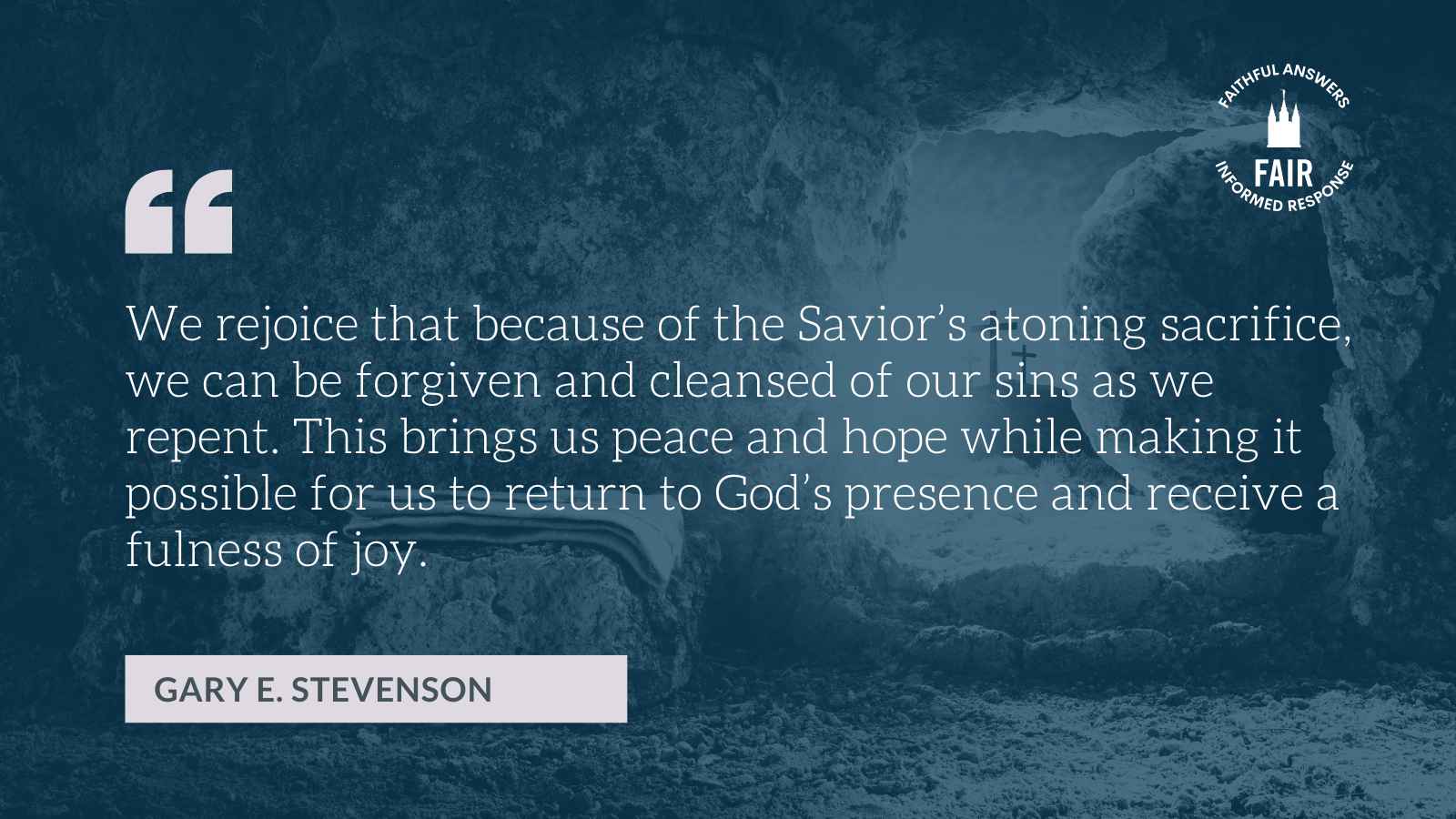
Apologetic Issues: Forgiveness vs. Reconciliation
Criticism: If I forgive someone, that means I’m obligated to reconcile with them—especially if I’m trying to be a ‘real Christian.’
Response: Forgiveness and reconciliation are not the same. Forgiveness is a personal, spiritual act—letting go of resentment and entrusting justice to God (see D&C 64:10–11). Reconciliation, however, involves mutual trust and safety and may not be possible—or even wise—in situations of abuse, betrayal, or repeated harm.
Elder Gary E. Stevenson teaches that “we rejoice that because of the Savior’s atoning sacrifice, we can be forgiven… This brings us peace and hope”. That same peace and hope are what we extend to others when we forgive—not a demand to restore broken relationships.
The Savior’s atonement provides the power to forgive without returning to harm. That is not weakness—it is faith in Christ’s justice and mercy.
Common Fallacy: Equivocation – When a single term is used in different ways without clarification.
The word forgiveness is equated with reconciliation, though they are distinct actions. Forgiveness is commanded; reconciliation is conditional.
Solution: Clarify terms. A faithful disciple can forgive without resuming unsafe contact. Forgiveness is vertical (between you and God); reconciliation is horizontal (between people) and requires mutual healing and trust.
Social Issue: Justice for Victims
Misconception: Forgiveness lets people get away with sin. If we forgive, there’s no justice.
Response: Forgiveness is not the absence of justice—it is trust that ultimate justice belongs to God. Elder Stevenson teaches that Christ’s Resurrection and Atonement mean that all wounds will be healed, and all wrongs made right in Him. Forgiveness means we no longer carry the burden of demanding compensation—we give it to the One who already paid the price.
Terry Warner explains:
Because we believe [Christ] paid for every sin, we do not desire to exact payment for whatever we have suffered. Instead, we are able freely to forgive.
Elder Kearon adds that victims are not responsible for what was done to them, and healing does not mean the wrong is excused—it means it is given to Christ:
You are not responsible… You are not less worthy… The Savior has descended below all things—even what has happened to you.
Common Fallacy: Straw Man – Misrepresenting a position to make it easier to attack.
This objection creates a straw man by misrepresenting forgiveness as permission for abuse. But forgiveness does not erase accountability—it entrusts it to God.
Correction: Christ does not overlook injustice—He atoned for it. Forgiveness doesn’t mean the offender “gets away with it.” It means the victim no longer has to carry the weight of vengeance.

Apologetic Application: Forgiveness Is an Act of Trust in Jesus Christ
Elder Gary E. Stevenson’s testimony in And We Talk of Christ affirms a profound doctrinal truth: because of Jesus Christ, we can be forgiven—and we can forgive. That power doesn’t come from minimizing injustice, but from trusting that Christ’s Atonement is enough to right every wrong and heal every wound.
Core Doctrine: The Atonement of Jesus Christ Enables Forgiveness. Forgiveness is not just a moral obligation—it is a sacred act of faith in the power of Jesus Christ. It means trusting that He has already suffered the full cost of the injustice, and that we don’t have to carry that pain alone.
The Atonement of Jesus Christ enables forgiveness not merely as a commandment but as a divine invitation to participate in the healing power of Christ’s suffering, mercy, and justice. When we choose to forgive, we are not declaring that the offense was insignificant or that justice no longer matters—we are testifying that Jesus Christ has already paid the full price for every wound, injustice, betrayal, and sin. His suffering in Gethsemane and on the cross bore not only our guilt as sinners but our grief as victims. As Isaiah declared, “He hath borne our griefs, and carried our sorrows” (Isaiah 53:4). Forgiveness, then, is not an act of weakness—it is an act of profound trust in the Savior’s promise that He will “judge between me and thee” and that His justice will not fail (D&C 64:11). It allows us to lay down the heavy burden of vengeance or resentment and walk forward in peace, knowing that Christ has already absorbed the cost and stands ready to both heal the wounded and hold the unrepentant accountable. This makes forgiveness an apologetic witness: it proclaims that we believe in a God who is both merciful and just, and who has conquered all things through His atoning love.
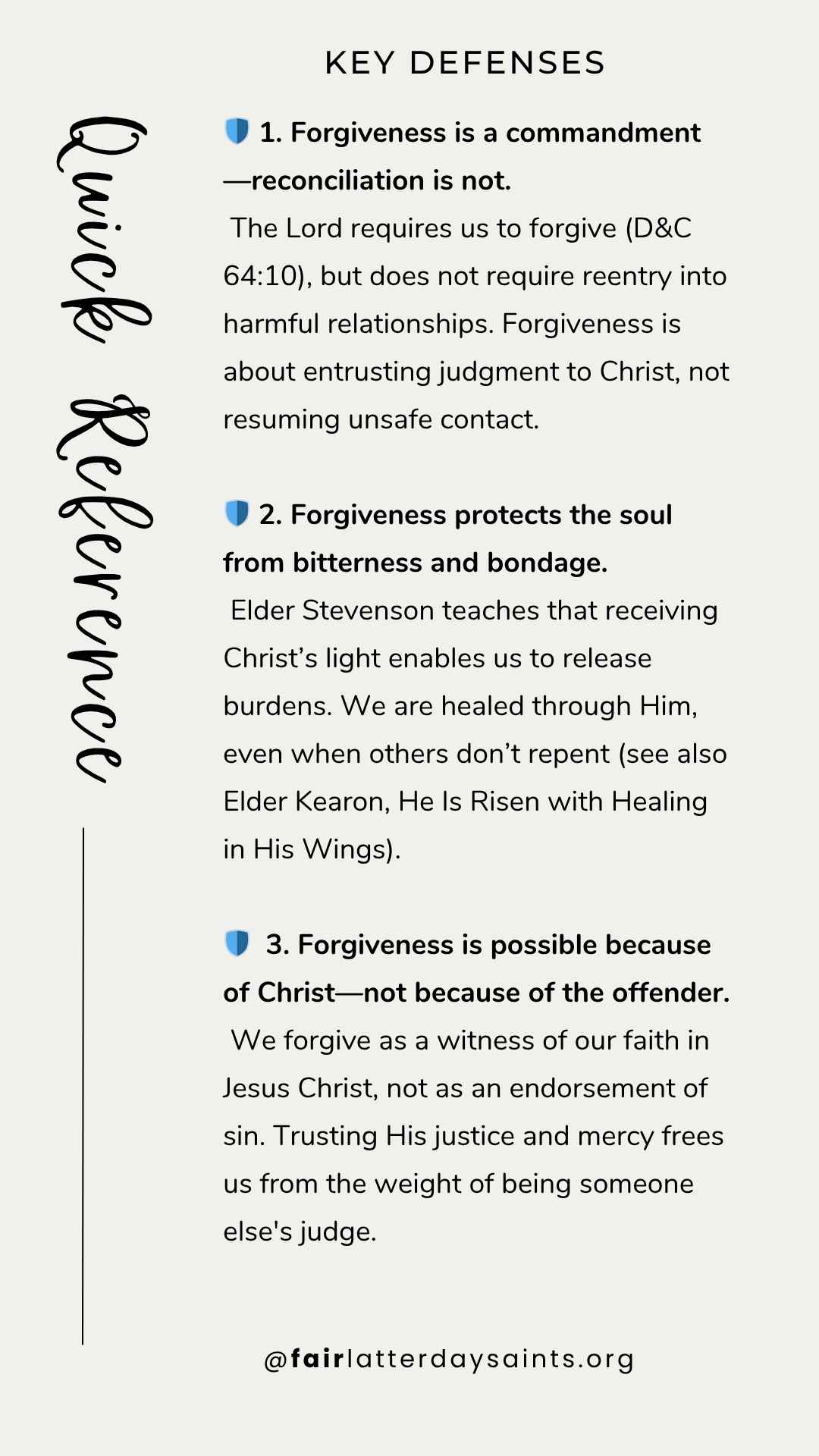 Defending Core Beliefs
Defending Core Beliefs
1⃣ Forgiveness ≠ Endorsing Sin. Critics often argue that forgiving someone is equivalent to saying their sin didn’t matter or wasn’t harmful. But that misunderstands the doctrine. Forgiveness is not excusing sin—it is handing judgment over to Christ, who already bore its full weight (see Mosiah 15:7–9).
Elder Holland affirms:
In order to forgive fully, you [do not] have to reenter a toxic relationship… But notwithstanding even the most terrible offenses, we can rise above our pain only when we walk the forgiving path.
Forgiveness says, “I choose to stop carrying this, because Christ already carried it for me.”
2⃣ Forgiveness Heals the Victim, Too. Forgiveness is often framed as a gift to the offender, but in Latter-day Saint doctrine, it’s also about liberating the victim.
“We suffer from doing wrong to others… But forgiving, we avoid doing ourselves terrible harm.” —C. Terry Warner
Letting go of resentment is a sacred form of personal healing through Christ. It helps the disciple stop defining their identity by the harm they’ve endured.
Forgiveness clarifies two key misunderstandings –
- It does not minimize evil. It confronts evil and places it squarely on the Savior’s shoulders, where justice and mercy meet.
- It does not mean reconciliation. It means peace, even if the relationship cannot be restored.
Practical Apologetic Use: This doctrine clarifies that forgiveness is not about removing accountability, but about trusting Christ to deliver justice perfectly. It relieves victims from carrying the burden of judgment and reorients the question from “Will they get away with it?” to “Do I trust the Savior enough to let Him carry both my pain and their consequence?”
Historical and Doctrinal Connections
Trusting Christ Then and Now: Forgiveness as a Pattern of Discipleship
In And We Talk of Christ, Elder Gary E. Stevenson bears witness of Christ’s power to forgive sins and fill us with peace and hope. His words echo a profound moment in Restoration history: in September 1831, the Lord chastened early Latter-day Saints in Missouri and Ohio for refusing to forgive one another.
Though those Saints had made covenants and sacrificed greatly, they still struggled to let go of personal offenses. The Lord responded with direct and sobering counsel in Doctrine and Covenants 64:
Ye ought to forgive one another; for he that forgiveth not… standeth condemned before the Lord… let God judge between me and thee (D&C 64:9–11).
That commandment still applies today. Elder Stevenson helps modern disciples understand that forgiveness is not a one-time act, but a process made possible through receiving the light of Christ and choosing to walk in it.
Just as early Saints had to learn to trust God with their wounds, so must we. The Lord didn’t ask them to deny what happened—but to stop carrying what only He could heal.
When we forgive, we act in faith that Christ’s Atonement is sufficient to judge sin, heal victims, and redeem all that is broken. This faith removes the burden of bitterness and replaces it with hope and peace, fulfilling the promise in D&C 64.
Living Apologetics: Forgiveness as a Witness of Christ
 How do we explain or live the doctrine of forgiveness when it feels impossible or unsafe?
How do we explain or live the doctrine of forgiveness when it feels impossible or unsafe?
Elder Gary E. Stevenson reminds us that receiving the Savior’s light enables us to act in faith, not fear—including in our efforts to forgive. “We receive the Savior’s light as we choose to have faith in Him, follow Him, and believe Him.”
Principle in Practice: Forgiveness Requires Trust in Christ, Not the Offender
Forgiveness is often misunderstood as reestablishing trust with someone who harmed us. But Elder Stevenson’s testimony—and the Lord’s words in D&C 64—make it clear: we forgive because we trust Christ to carry the burden of justice.
1⃣ Set boundaries and still forgive.
From this week’s Come, Follow Me: “Forgiveness does not mean we allow others to hurt us.” Teach that forgiveness can exist without reconciliation. This principle corrects common critiques that Latter-day Saints minimize abuse or trauma.
2⃣ Explain that forgiveness is an act of strength, not weakness.
Use examples like Jesus on the cross (“Father, forgive them”), or Saints who forgive amid tragedy—not because the offense is small, but because the Savior is mighty.
Top Apologetic Facts
 1. Forgiveness is a commandment, not a concession.
1. Forgiveness is a commandment, not a concession.
Doctrine and Covenants 64 teaches that refusing to forgive brings spiritual condemnation. Forgiveness is not excusing sin—it’s obeying Christ’s command to release others to His justice and receive peace through Him.
 2. Trusting Christ means trusting His justice.
2. Trusting Christ means trusting His justice.
Elder Stevenson affirms that forgiveness is only possible through Christ’s healing power. By placing judgment in the Lord’s hands, we declare our faith in His ability to heal us and deal justly with others—even when we cannot see how.
 3. Forgiveness does not require reconciliation.
3. Forgiveness does not require reconciliation.
Both Elder Holland and this week’s Come, Follow Me lesson emphasize that forgiveness is compatible with healthy boundaries. Letting go of resentment doesn’t mean returning to harmful relationships—it means moving forward with Christ.
Conclusion: Forgiving in the Light of Christ
Elder Gary E. Stevenson’s testimony is a call to draw nearer to Christ—not just by speaking of Him, but by receiving His light so deeply that it changes how we carry sorrow, how we view justice, and how we respond to those who hurt us.
His message reminds us that forgiveness is not about forgetting or enabling sin—it’s about choosing to trust the Savior more than our pain. As we walk in His light, we are enabled to lay down burdens that were never ours to carry. We can forgive without compromising safety. We can find joy even amid injustice. We can move forward, not because others have changed, but because we have been changed through Christ.
This is the heart of Christian discipleship—and the heart of Latter-day Saint apologetics: bearing witness that Christ’s power is real, and that it works in the messy, painful places of life.
Forgiveness is a gift we give to ourselves by trusting in the Lord and letting His light heal us.
What burden are you still carrying that Christ is willing to carry for you?
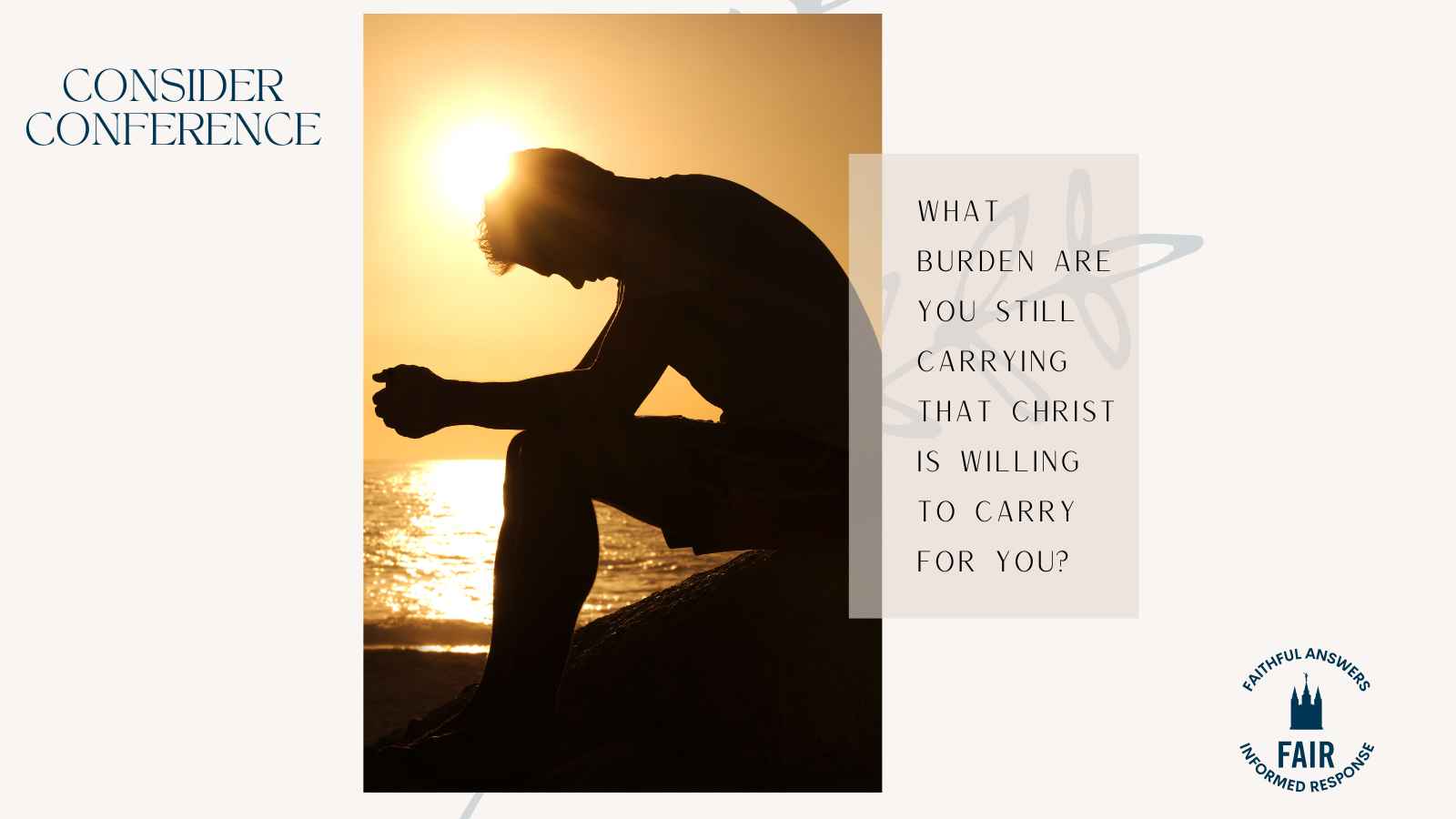
The Consider Conference series by FAIR offers an in-depth look at recent General Conference talks to help members of the Church of Jesus Christ of Latter-day Saints navigate common questions, misunderstandings, and criticisms. Each post provides doctrinal insights, historical context, and practical ways to apply gospel principles in everyday conversations. Through this series, we hope to equip readers with faith-promoting resources that encourage thoughtful reflection, respectful dialogue, and a stronger foundation in gospel truths, fostering both personal conviction and meaningful discussions with others.
The post And We Talk of Christ: Forgiving Through His Light appeared first on FAIR.
Continue reading at the original source →




